2. 中国农业大学曲周实验站 曲周 057250
2. Quzhou Experimental Station, China Agricultural University, Quzhou 057250, China
近年来, 我国设施蔬菜种植面积稳居世界第一, 设施蔬菜呈现出生产效益明显提升、管理水平逐步提高的良好势头[1]。设施蔬菜种植可以高效利用环境因子, 增加蔬菜生产周期, 提高蔬菜产量[2], 但也普遍存在着氮磷投入过量且比例失调、有机肥使用不合理等现象[3]。研究表明, 长期不合理施肥会导致土壤养分在降雨或灌溉条件下向土壤深层淋溶, 对地下水环境造成危害[4-8]。
长期定位肥料试验具有常规试验不可比拟的优点, 通过长期定位施肥研究, 能系统地研究不同施肥制度对土壤物理、化学性质等因子的影响, 为农业的可持续发展提供决策依据[9]。目前, 国内外有关长期定位施肥的研究很多, 主要围绕“作物-土壤”两大方面[9-11]。研究表明, 长期施用有机肥和化肥均能持续提升土壤氮、磷养分含量[12-17], 有机肥效果优于化肥, 且表现出随有机肥用量的增加而增加[12]。长期施用有机肥或有机肥与化肥配施可明显改善土壤物理性状, 增强土壤酶活性, 长期单施化肥造成土壤pH和土壤酶活性降低, 而土壤酶活性与土壤有机质、氮、磷养分含量呈显著正相关[17]。长期持续施入有机肥能够有效地增加土壤全氮、微生物量氮、潜在矿化氮和颗粒有机氮含量, 有助于保持土壤供氮能力[18]。有机肥的长期施用可显著增加土壤中各形态的磷素含量[13, 19], 化肥配施有机肥有助于活化土壤磷, 提升土壤有效磷含量, 有利于土壤有效磷的稳定供给[14]。土壤有机质含量表现出随有机肥施用量的增加而增高, 且有逐年增长的趋势[12, 14]。
由于蔬菜根系分布浅, 灌溉量大, 过量施用氮肥, 会引起氮素淋失, 对环境造成污染[7, 20]。McLay等[21]研究指出, 较严重的地下水硝酸盐污染主要与化肥施用量较高的蔬菜种植有关, 蔬菜种植区的地下水硝酸盐含量明显高于粮食作物种植区。与施用化学肥料相比, 施用有机肥能明显降低土壤剖面硝态氮含量, 控制其累积峰的下移, 但不合理施用有机肥也可能导致氮素大量淋失[22]。有机肥可以对各种形态磷起活化作用, 有效地提高土壤全磷、速效磷含量[23], 菜地长期大量施用有机肥会导致土壤总磷和速效磷含量增加, 降低对磷的吸附, 促进磷素的淋溶损失[24]。
设施菜田具有肥料投入量大、有机肥投入比例高的特点[25], 长期大量施用有机肥与化肥会对土壤养分含量、理化性质产生显著影响, 进而影响土壤氮、磷养分淋溶, 增加养分淋失风险[26-27]。但目前关于长期定位施肥下设施蔬菜生产, 特别是有关比较有机种植与常规种植体系土壤养分淋溶的研究比较少。本研究以中国农业大学曲周试验站日光温室有机蔬菜长期定位试验为基础, 研究不同种植模式 (有机、综合、常规) 下土壤氮、磷、COD淋溶累积量及其动态变化, 以期为控制设施菜田养分淋失风险, 发展安全、高效、环境友好的设施蔬菜种植模式提供借鉴。
1 材料与方法 1.1 试验地概况试验地位于河北省邯郸市曲周县北部中国农业大学曲周实验站 (36 52'N, 115 01'E), 试验于2002年3月开始, 是针对有机蔬菜生产进行的长期定位研究。当地属温带半湿润季风气候区, 光、热、水等气候资源比较丰富, 但受季风的强烈影响, 冬春寒冷干燥, 夏季温暖多雨, 年均降水量604 mm, 属一年两熟种植区。试验采用的日光温室为拱圆式, 长52 m、宽7 m, 占地面积约0.04 hm2。供试土壤为治理后的盐化潮褐土, 试验前为多年菜田, 试验开始前土壤基础养分状况如表 1所示。
| 表1 2002年试验前与2014年茄子定植前不同种植模式温室土壤基础养分状况 Table 1 Soil nutrients contents of three different greenhourse vegatable cropping systems before the experiment in 2002 and before engraftment of eggplant in 2014 |
试验设有机、综合和常规种植3个处理。1) 有机种植模式 (ORG):采用有机蔬菜生产方式, 只施用有机肥。病虫害防治以生物和物理防治为主, 并辅以生物药剂防治。2) 综合种植模式 (INT):遵照综合蔬菜生产方式, 施用有机肥和少量化肥。病虫害防治以生物和物理防治为主, 比较严重时少量使用一些低毒低残留农药。3) 常规种植模式 (CON):采用常规蔬菜种植方法, 施用化肥和少量有机肥, 追施尿素。病虫害防治以化学防治为主, 使用国家规定的高效低毒农药控制病虫害。化肥中氮肥为尿素、磷肥为过磷酸钙、钾肥为氯化钾, 有机肥由当地养殖场生产的牛粪、鸡粪 (湿牛粪15000 kg, 干鸡粪4000 kg) 添加北京沃土天地生物有限公司生产的VT菌剂后堆置而成。
3种蔬菜种植模式分别在3个温室进行, 每个温室内平分为3个小区, 每个小区120 m2, 作为3个重复。2014年春季种植蔬菜为茄子 (Solanum melon-gena L.), 品种为‘霸王茄’, 由‘托鲁巴姆’根嫁接, 各模式下均种植865株, 于2月20日定植, 9月5日全部收获; 秋季种植蔬菜为芹菜 (Apium graveolens L.), 品种为‘美国西芹’, 各模式下均种植11000株, 于2014年10月19日定植, 2015年2月5日全部收获。
3个温室的灌溉方式均为大水漫灌, 试验期间共进行13次灌溉, 每次每棚均为975 m3·hm-2, 灌溉时间为: 2014年2月20日、3月20日、4月13日、5月1日、5月24日、6月1日、6月15日、7月15日、8月24日、10月19日、11月16日、12月20日和2015年1月24日。春茬茄子在2014年2月10日施基肥, 并在4月30日进行追肥, 基肥与追肥养分投入比例为5:1, 秋茬芹菜只在10月14日施1次基肥, 具体养分投入量见表 2。
| 表2 不同种植模式温室蔬菜投入养分量 Table 2 Nutrients application rates of different greenhourse vegatable cropping systems kg·hm-2 |
1) 土壤样品采集:每个处理分为3个取样小区, 于植株行正中间用土钻采集, 取样深度为0~40 cm, 每20 cm为一层, 每个小区按Z字形取5钻, 混匀。土样取回后剔除石砾和植物残根等杂物后风干保存, 用于理化性质测定。取样时间分别为2014年2月8日和2014年10月13日。
2) 淋溶水收集:采用渗漏计装置收集淋溶水。蔬菜种植前, 在每个温室各小区的中间位置分别挖1底面积0.5 m×0.5 m、深1 m的坑, 在坑的底部沟槽继续垂直深挖1个平面斜坡, 斜坡一边距地面1 m, 另一边距地面1.1 m, 用于放置渗漏计。在坑壁的一侧沿斜坡挖1个20 cm的沟槽用于放软管, 在另一侧挖1个直径0.11 m, 深1.6 m的坑用于放接收装置。灌溉后4~6 d内, 用提水器将接收装置内的淋溶水取出, 记录总的淋溶水体积, 收集一部分分别放入3个50 mL的离心管内, 作为3平行样, 并标注编号和取样时间, 立即放入冰盒内贮存, 带回实验室于-20℃保存, 待测。本试验在2014—2015年春茬和秋茬共进行13次取样, 取样时间分别为2014年2月26日、3月25日、4月17日、5月5日、5月28日、6月5日、6月20日、7月19日、8月30日、10月24日、11月20日、12月24日和2015年1月30日。
1.4 测定项目与方法总氮:碱性过硫酸钾消解-紫外分光光度法; 总磷:钼酸铵分光光度法; COD:快速消解-分光光度法。
100 cm土层淋溶水的总氮、总磷、COD计算公式如下:
| ${\rm{P}} = \frac{{\sum\limits_{{\rm{i}}\; = \;1}^{\rm{n}} {{{\rm{C}}_{\rm{i}}} \times {{\rm{V}}_{\rm{i}}}} }}{{{\rm{A}} \times 4 \times {{10}^5}}}$ | (1) |
式中: P为氮、磷、COD的流失量, kg·hm-2; Ci为第i次淋溶水中氮、磷、COD的浓度, μg·mL-1; Vi为第i次淋溶水的总体积, mL; A为大棚面积, hm2; n为取样次数。
1.5 数据处理及分析数据经过Microsoft Excel 2010程序进行整理, 数据变异性及方差分析使用SPSS v.20.0程序, 绘图用SigmaPlot 12.0完成。
2 结果与分析 2.1 不同种植模式温室蔬菜土壤总氮淋失量及淋失动态 2.1.1 总氮淋失量不同种植模式下土壤总氮淋失量见图 1。常规种植模式在2014年春茬茄子和秋茬芹菜种植期内的总氮淋失量均为最高, 分别是129.79 kg·hm-2和55.14 kg·hm-2; 春茬茄子总氮淋失量有机模式为98.00 kg·hm-2, 显著低于常规模式和综合模式, 而综合模式与常规模式差异不明显; 秋茬芹菜总氮淋失量综合模式最低, 为32.96 kg·hm-2, 有机模式为39.02 kg·hm-2, 均显著低于常规模式。综合表 2和图 1可知, 春茬茄子常规模式和综合模式氮素投入量分别比有机模式高32.9%和4.1%, 总氮淋失量分别比有机模式高32.4%和25.3%;秋茬芹菜常规模式和综合模式氮素投入量分别为有机模式氮素投入量的98.4%和84.5%, 总氮淋失量分别为有机模式的141.3%和84.5%。总体来说, 有机模式有助于减少氮素淋失, 秋茬芹菜淋失量较综合模式高, 可能与其氮素投入量最高有关。常规模式春秋两茬蔬菜一直表现出较高的氮素淋失量, 这可能与肥料投入量高有一定关系, 更主要的原因可能是化肥较有机肥养分释放快, 易随水淋失。
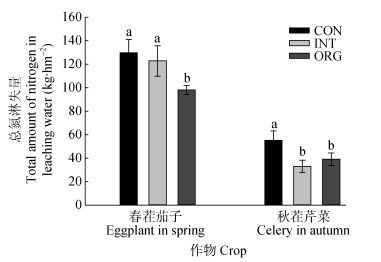
|
图 1 不同种植模式温室蔬菜土壤的总氮淋失量 Figure 1 Total nitrogen leaching amounts in different greenhourse vegatable cropping systems 不同小写字母表示处理间在0.05水平上差异显著。 Different lowercase letters indicate significant differences among treatments at 0.05 level. |
由图 2可知, 春茬茄子期间, 3种种植模式总氮淋失量在茄子生长前期维持在较高水平, 并分别在3月25日和5月5日出现较明显峰值, 这一现象可能是由于2月10日施加了基肥, 并在4月30日进行了追肥, 经过几次灌溉, 氮素随水向下运移造成的。进入6月份, 总氮淋失量迅速降低, 并一直处于较低水平, 可能是由于茄子生长旺盛, 吸氮量增大, 加上前期氮素的淋溶损失, 土壤氮素含量有所下降。有机模式下总氮淋失量一直处于较低水平, 且波动相对平缓, 这可能与有机肥养分释放缓慢有关。常规模式在施肥后总氮淋失量最高, 表明化肥有养分释放快, 易随水淋失的特点。由于芹菜生长季较短, 大棚冬季水分蒸发量小, 秋茬芹菜期间仅进行4次灌溉, 总的来说淋溶趋势与春茬茄子相似, 12月24日淋失量达到峰值后迅速降低。
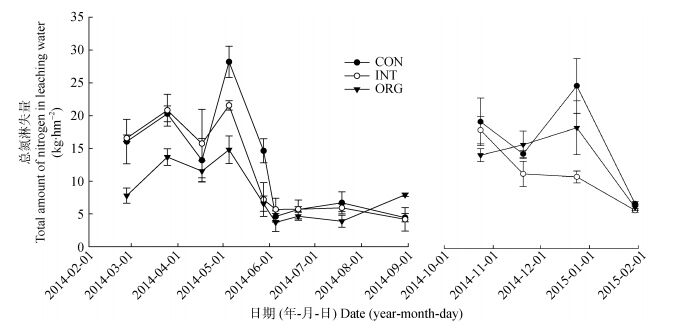
|
图 2 不同种植模式下温室蔬菜土壤总氮淋溶量动态变化 Figure 2 Dynamic changes of total nitrogen leaching in different greenhourse vegatable cropping systems |
图 3为2014年不同种植模式下春茬茄子和秋茬芹菜总磷淋失量, 两茬均为有机种植模式下最高, 综合次之, 常规最低。春茬茄子期间, 有机和综合模式下的总磷淋失量分别为9.77 kg·hm-2和6.46 kg·hm-2, 分别比常规模式高111.0%和39.5%;秋茬芹菜期间, 有机和综合模式的总磷淋失量分别为8.12 kg·hm-2和5.66 kg·hm-2, 分别比常规模式高121.9%和54.6%, 不同处理间差异显著。不同种植模式磷素投入量为常规 > 综合 > 有机 (表 2)。有机种植模式磷素投入量少, 淋失量大, 可能是因为有机肥带入大量易分解释放的有机磷, 同时活化了土壤中的吸附态磷。
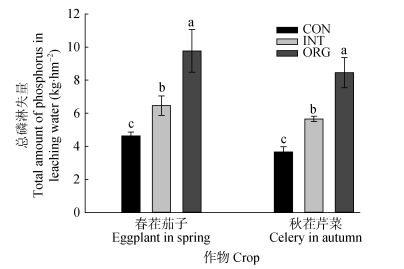
|
图 3 不同种植模式温室蔬菜土壤总磷淋失量 Figure 3 Total phosphorus leaching amounts in different greenhourse vegatable cropping systems 不同小写字母表示处理间在0.05水平上差异显著。 Different lowercase letters indicate significant differences among treatments at 0.05 level. |
如图 4所示, 3种蔬菜种植模式下不同时期磷素淋失量与磷素淋失总量变化趋势相同, 均为常规模式 < 综合模式 < 有机模式。不同种植模式下土壤磷素淋失量均较少, 可能是因为土壤对磷有强烈的固定作用[28], 大部分磷转化为不易溶解的固定态磷, 极少部分进入土壤溶液。春茬茄子总磷淋失量呈现先增加后减小的趋势。这一现象可能是随着气温的升高, 微生物逐渐活动旺盛, 难溶性磷被分解释放出来[29]。到了茄子生长后期, 由于之前水溶态磷及部分被活化的吸附态磷随水淋失, 加上作物对磷的吸收, 导致磷的淋失量逐步减少。
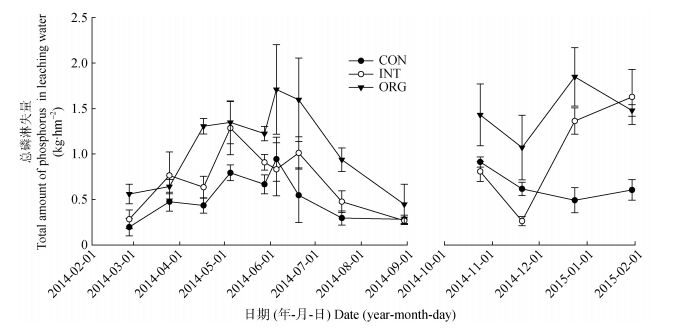
|
图 4 不同种植模式温室蔬菜土壤总磷淋溶量动态变化 Figure 4 Dynamic changes of total phosphorus leaching in different greenhourse vegatable cropping systems |
化学需氧量 (COD) 是表征水中有机物含量, 评价水体污染的重要指标之一。图 5为不同种植模式下的淋溶水COD, 两茬蔬菜均为综合模式最低, 分别为451.71 kg·hm-2和127.21 kg·hm-2。春茬茄子期间, 有机模式淋溶水COD达658.78 kg·hm-2, 分别比综合和常规模式高45.8%和6.87%;秋茬芹菜期间, 常规模式淋溶水COD为215.10 kg·hm-2, 分别比综合和有机模式高69.1%和8.5%。有机模式淋溶水COD较高的原因可能是有机肥的施加给土壤带入大量易随水淋失的可溶性有机物, 增加了淋溶水中有机物含量[30]。常规模式有机肥施入量较综合模式少, 但其淋溶水COD比综合模式高, 这一结果有待进一步分析验证。

|
图 5 不同种植模式温室蔬菜土壤的淋溶水COD Figure 5 COD in leaching water under different greenhourse vegatable cropping systems 不同小写字母表示处理间在0.05水平上差异显著。 Different lowercase letters indicate significant differences among treatments at 0.05 level. |
如图 6所示, 2014年春茬茄子淋溶水COD呈先下降后明显上升的趋势, 而秋茬芹菜淋溶水COD变化呈现先上升后下降的相反趋势。这可能与一年内气温变化相关: 3—8月, 气温回升, 灌溉频繁, 微生物活动旺盛, 土壤易溶的有机物含量逐渐增加[31], 导致淋溶水COD增加; 11月到翌年1月末, 土壤温度较低, 微生物活性下降, 淋溶水COD减少。
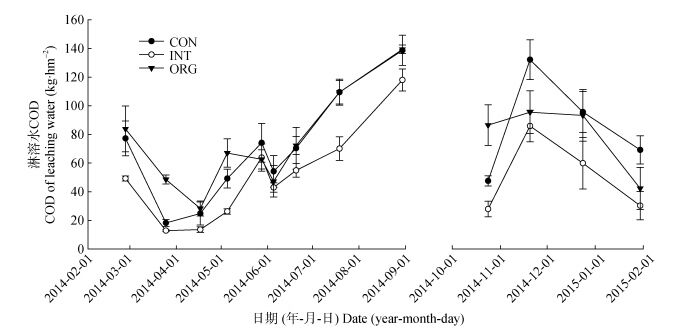
|
图 6 不同种植模式温室蔬菜土壤淋溶水COD动态变化 Figure 6 Dynamic changes of COD in leaching water under different greenhourse vegatable cropping systems |
本试验3个处理氮、磷、钾养分投入量存在一些差异, 但通过试验结果可以得出, 有机模式在一定程度上有利于减少土壤氮素淋失, 效果优于常规模式和综合模式。前期的研究[32]表明, 有机种植模式与综合、常规种植模式相比, 有较低的氮素投入、较高的氮素输出 (作物吸收), 从2002年试验开始到2014年0~20 cm和20~40 cm土层总氮含量有机模式上升最为明显, 综合模式次之, 常规模式基本保持不变, 说明有机模式在减少氮素损失方面较综合和常规模式具有优势, 同时还能持续提高土壤肥力。有机肥中有机氮含量较高, 易淋洗的硝态氮比例较化肥低, 使得有机种植模式总氮淋洗动态变化相对平稳且氮素淋失量相对较少。同时, 施用有机肥能够增加土壤有机质与团聚体的含量, 提高土壤持水性[33-34], 增强对各种离子的吸附能力, 延缓养分释放过程, 从而提高土壤的保肥性, 减少土壤氮素的淋失[35-36]; 但有机肥投入过量也会增加土壤氮素淋失, 秋茬芹菜有机模式氮素投入量最大, 比综合模式高18.3%, 总氮淋失量也比综合模式总氮淋失量高18.4%, 在减少氮素淋溶方面并未表现出优势。
有机种植模式长期的有机肥投入提高了土壤肥力, 茄子定植前土壤速效磷含量达常规模式的3倍以上, 高含量的速效磷增加了土壤磷素随灌溉水淋失的风险。土壤总磷淋失结果表明, 有机种植模式显著增加了土壤磷素淋失风险, 且土壤磷素淋失量随有机肥施用比例的增加而增加。有机种植模式在磷素投入较少的情况下, 仍然有最高的总磷淋失量, 可能是因为有机肥提高了土壤有机质含量和土壤微生物包括有机磷矿化细菌数量[37-38], 促进磷素向可溶性磷的转化。有机肥分解过程中产生的有机酸能够与土壤颗粒表面的磷酸根离子发生置换反应, 对土壤磷素有活化作用, 增加土壤溶解态磷含量[23, 39]。肖辉等[40]、宇万太等[41]、陈新等[42]的研究也表明, 施用有机肥能显著提高土壤速效磷含量, 促进土壤磷素淋失, 且随有机肥用量的增加而增加。磷肥施入土壤后, 经过一系列化学、物理化学和生物化学过程, 磷素迅速被土壤矿物吸附或被微生物固持[43], 3种模式下总磷淋失量最低不足磷素投入量的1%, 最高不足磷素投入量的5%, 说明淋溶不会引起土壤磷素大量损失, 长期大量投入磷肥会导致磷在土壤中富集。
COD作为衡量水中有机物相对含量的综合指标之一, 淋溶水中有机物含量越高, COD越高。有关淋溶水COD的研究不多。有研究表明, 淋溶水COD与总氮、总磷呈显著正相关[44-45], 这可能是常规模式淋溶水COD较高的原因之一。本试验结果表明, 综合模式较有机和常规模式有助于减少淋溶水COD, 有机模式施用有机肥量较高, 带入大量有机物, 可能是导致其淋溶水COD较高的主要原因, 但还不能得出施用有机肥导致淋溶水COD增加的结论, 因为常规模式有机肥投入量最少, 但在春秋两茬淋溶水COD一直较高, 具体原因还需要进一步分析。
综合来看, 有机种植模式较综合模式和常规模式在一定程度上能够减少氮素淋失, 增加磷素淋失, 但土壤氮素淋失量远大于磷素淋失量, 且有机种植模式显著提高了土壤全氮、速效磷和有机质含量。因此, 与综合模式和常规模式相比, 有机种植模式有利于减少养分淋失, 提高土壤肥力。
| [1] |
喻景权, 周杰. "十二五"我国设施蔬菜生产和科技进展及其展望[J/OL]. 中国蔬菜, http://www.cnki.net/kcms/detail/11.2326.S.20160825.0853.058.html
Yu J Q, Zhou J. Progress and prospect of greenhouse vegetable production and science and technology in China in 12th Five-Year[J/OL]. China Vegetables, http://www.cnki.net/kcms/detail/11.2326.S.20160825.0853.058.html |
| [2] |
张利华, 王少平, 张永强, 等.
日光温室增光保温的研究进展[J]. 江西农业学报, 2010, 22(7): 136–138.
Zhang L H, Wang S P, Zhang Y Q, et al. Review of increasing of illumination and heat preservation in solar greenhouse[J]. Acta Agriculturae Jiangxi, 2010, 22(7): 136–138. |
| [3] |
刘孝慧, 殷晓蓉, 郭吉山, 等.
设施蔬菜施肥存在的问题及对策措施[J]. 中国园艺文摘, 2015, 31(1): 162–163.
Liu X H, Yin X R, Guo J S, et al. Problems and countermeasures of fertilization in greenhouse vegetable cultivation[J]. Chinese Horticulture Abstracts, 2015, 31(1): 162–163. |
| [4] |
习斌, 翟丽梅, 刘申, 等.
有机无机肥配施对玉米产量及土壤氮磷淋溶的影响[J]. 植物营养与肥料学报, 2015, 21(2): 326–335.
Xi B, Zhai L M, Liu S, et al. Effects of combination of organic and inorganic fertilization on maize yield and soil nitrogen and phosphorus leaching[J]. Journal of Plant Nutrition and Fertilizer, 2015, 21(2): 326–335. |
| [5] |
张宏威, 康凌云, 梁斌, 等.
长期大量施肥增加设施菜田土壤可溶性有机氮淋溶风险[J]. 农业工程学报, 2013, 29(21): 99–107.
Zhang H W, Kang L Y, Liang B, et al. Long-term heavy ferti-lization increases leaching risk of soil soluble organic nitrogen in vegetable greenhouse[J]. Transactions of the CSAE, 2013, 29(21): 99–107. DOI:10.3969/j.issn.1002-6819.2013.21.013 |
| [6] |
田琳琳. 太湖流域蔬菜地施肥模式对氮磷流失的影响[D]. 南京: 南京师范大学, 2012: 55-56
Tian L L. Effects of different fertilization modes on nitrogen and phosphorus output of vegetable land in Taihu Lake wa-tershed[D]. Nanjing:Nanjing Normal University, 2012:55-56 |
| [7] |
吴雪玲, 左强, 吴建新, 等.
保护地菜田土壤氮素淋溶阻控措施及其效果研究[J]. 水土保持学报, 2011, 25(3): 59–62.
Wu X L, Zuo Q, Wu J X, et al. Study on measures for reducing nitrogen leaching from facility vegetable field[J]. Journal of Soil and Water Conservation, 2011, 25(3): 59–62. |
| [8] |
聂斌. 有机-无机肥不同配比对设施番茄生长、土壤肥力及氮素淋失的影响[D]. 长沙: 湖南农业大学, 2012: 35-41
Nie B. Effects of different mixing ratio of manure and chemical fertilizer on tomato growth, soil fertility improvement and nitrogen leaching in greenhouse cultivation[D]. Changsha:Hunan Agricultural University, 2012:35-41 |
| [9] |
聂胜委, 黄绍敏, 张水清, 等.
长期定位施肥对土壤效应的研究进展[J]. 土壤, 2012, 44(2): 188–196.
Nie S W, Huang S M, Zhang S Q, et al. Effects of long-term located fertilization on soils:A review[J]. Soils, 2012, 44(2): 188–196. |
| [10] |
李清华.
长期施肥对土壤有机碳、氮组分及微生物多样性影响的研究进展[J]. 湖南农业科学, 2013(1): 36–39.
Li Q H. Advances in influences of long-term fertilization on organic carbon, nitrogen component and microbial diversity in soil[J]. Hunan Agricultural Sciences, 2013(1): 36–39. |
| [11] |
聂胜委, 黄绍敏, 张水清, 等.
长期定位施肥对作物效应的研究进展[J]. 土壤通报, 2012, 43(4): 979–987.
Nie S W, Huang S M, Zhang S Q, et al. Advances in research on effects of long-term located fertilization on crops[J]. Chinese Journal of Soil Science, 2012, 43(4): 979–987. |
| [12] |
林治安, 赵秉强, 袁亮, 等.
长期定位施肥对土壤养分与作物产量的影响[J]. 中国农业科学, 2009, 42(8): 2809–2819.
Lin Z A, Zhao B Q, Yuan L, et al. Effects of organic manure and fertilizers long-term located application on soil fertility and crop yield[J]. Scientia Agricultura Sinica, 2009, 42(8): 2809–2819. |
| [13] |
杨丽娟, 李天来, 周崇峻.
塑料大棚内长期施肥对菜田土壤磷素组成及其含量影响[J]. 水土保持学报, 2009, 23(5): 205–208.
Yang L J, Li T L, Zhou C J. Long-term fertilization effect on fraction and content of phosphorus in vegetable soil in plastic film house[J]. Journal of Soil and Water Conservation, 2009, 23(5): 205–208. |
| [14] |
张淑香, 张文菊, 沈仁芳, 等.
我国典型农田长期施肥土壤肥力变化与研究展望[J]. 植物营养与肥料学报, 2015, 21(6): 1389–1393.
Zhang S X, Zhang W J, Shen R F, et al. Variation of soil quality in typical farmlands in China under long-term fertilization and research expedition[J]. Journal of Plant Nutrition and Fertilizer, 2015, 21(6): 1389–1393. DOI:10.11674/zwyf.2015.0602 |
| [15] |
全智, 吴金水, 魏文学, 等.
长期种植蔬菜后土壤中氮、磷有效养分和重金属含量变化[J]. 应用生态学报, 2011, 22(11): 2919–2929.
Quan Z, Wu J S, Wei W X, et al. Change characteristics of soil available nitrogen and phosphorus and heavy metal contents after long-term cultivation of vegetables[J]. Chinese Journal of Applied Ecology, 2011, 22(11): 2919–2929. |
| [16] |
张玉树, 丁洪, 王飞, 等.
长期施用不同肥料的土壤有机氮组分变化特征[J]. 农业环境科学学报, 2014, 33(10): 1981–1986.
Zhang Y S, Ding H, Wang F, et al. Characteristics of organic nitrogen fractions in soils under long-term different fertiliza-tion[J]. Journal of Agro-Environment Science, 2014, 33(10): 1981–1986. DOI:10.11654/jaes.2014.10.015 |
| [17] |
马宁宁, 李天来, 武春成, 等.
长期施肥对设施菜田土壤酶活性及土壤理化性状的影响[J]. 应用生态学报, 2010, 21(7): 1766–1771.
Ma N N, Li T L, Wu C C, et al. Effects of long-term fertilization on soil enzyme activities and soil physicochemical properties of facility vegetable field[J]. Chinese Journal of Applied Ecology, 2010, 21(7): 1766–1771. |
| [18] |
赵丹丹, 王俊, 付鑫.
长期定位施肥对旱作农田土壤全氮及其组分的影响[J]. 水土保持学报, 2016, 30(4): 303–307.
Zhao D D, Wang J, Fu X. Effect of long-term fertilization on soil total nitrogen and its fractions in dryland farming sys-tem[J]. Journal of Soil and Water Conservation, 2016, 30(4): 303–307. |
| [19] |
吴玉梅, 梁成华, 杜立宇, 等.
长期定位施肥对蔬菜保护地土壤磷素形态的影响[J]. 中国土壤与肥料, 2009(3): 39–43.
Wu Y M, Liang C H, Du L Y, et al. Effects of long-term located using fertilization on the phosphorus fractions of vegetable planted soils in greenhouse[J]. Soil and Fertilizer Sciences in China, 2009(3): 39–43. |
| [20] |
侯利敏, 王凌, 孙世友, 等.
河北露地蔬菜土壤硝态氮淋溶特征及影响因素研究[J]. 华北农学报, 2016, 31(S1): 364–368.
Hou L M, Wang L, Sun S Y, et al. The nitrate leaching char-acteristics and different effect factors in open-field soil in Hebei Province[J]. Acta Agriculturae Boreali-Sinica, 2016, 31(S1): 364–368. DOI:10.7668/hbnxb.2016.S1.061 |
| [21] | McLay C D A, Dragten R, Sparling G, et al. Predicting groundwater nitrate concentrations in a region of mixed agri-cultural land use:A comparison of three approaches[J]. Environmental Pollution, 2001, 115(2): 191–204. DOI:10.1016/S0269-7491(01)00111-7 |
| [22] |
杨合法, 范聚芳, 梁丽娜, 等.
长期不同施肥模式对日光温室土壤硝态氮时空分布及累积的影响[J]. 中国生态农业学报, 2011, 19(2): 246–252.
Yang H F, Fan J F, Liang L N, et al. Effects of long-term fer-tilization modes on spatio-temporal distribution and accumulation of soil nitrate nitrogen in solar greenhouse[J]. Chinese Journal of Eco-Agriculture, 2011, 19(2): 246–252. |
| [23] |
章永松, 林咸永, 罗安程, 等.
有机肥 (物) 对土壤中磷的活化作用及机理研究——Ⅰ.有机肥 (物) 对土壤不同形态无机磷的活化作用[J]. 植物营养与肥料学报, 1198, 4(2): 145–150.
Zhang Y S, Lin X Y, Luo A C, et al. Studies on activation of phosphorus by organic manure in soils and its mechanisms-Ⅰ. Effect of organic manure (matter) on activation to different phosphate in soils[J]. Journal of Plant Nutrition and Fertilizer, 1198, 4(2): 145–150. |
| [24] |
高德才, 张蕾, 刘强, 等.
菜地土壤氮磷污染现状及其防控措施[J]. 湖南农业科学, 2013(17): 51–55.
Gao D C, Zhang L, Liu Q, et al. Present status of nitrogen and phosphorus pollution in vegetable fields and its control measures[J]. Hunan Agricultural Sciences, 2013(17): 51–55. DOI:10.3969/j.issn.1006-060X.2013.17.016 |
| [25] |
刘兆辉, 江丽华, 张文君, 等.
山东省设施蔬菜施肥量演变及土壤养分变化规律[J]. 土壤学报, 2008, 45(2): 296–303.
Liu Z H, Jiang L H, Zhang W J, et al. Evolution of fertilization rate and variation of soil nutrient contents in greenhouse vegetable cultivation in Shandong[J]. Acta Pedologica Sinica, 2008, 45(2): 296–303. |
| [26] |
王敬, 程谊, 蔡祖聪, 等.
长期施肥对农田土壤氮素关键转化过程的影响[J]. 土壤学报, 2016, 53(2): 292–304.
Wang J, Cheng Y, Cai Z C, et al. Effects of long-term fertilization on key processes of soil nitrogen cycling in agricultural soil:A review[J]. Acta Pedologica Sinica, 2016, 53(2): 292–304. |
| [27] |
许俊香, 邹国元, 孙钦平, 等.
施用有机肥对蔬菜生长和土壤磷素累积的影响[J]. 核农学报, 2016, 30(9): 1824–1832.
Xu J X, Zou G Y, Sun Q P, et al. Effects of application manure on Olsen-P accumulation and distribution in soil profile and the yield of vegetable[J]. Journal of Nuclear Agricultural Sciences, 2016, 30(9): 1824–1832. DOI:10.11869/j.issn.100-8551.2016.09.1824 |
| [28] |
安迪, 杨令, 王冠达, 等.
磷在土壤中的固定机制和磷肥的高效利用[J]. 化工进展, 2013, 32(8): 1967–1973.
An D, Yang L, Wang G D, et al. Mechanisms of phosphorus fixation in soils and efficient utilization of phosphate fertilizer[J]. Chemical Industry and Engineering Progress, 2013, 32(8): 1967–1973. |
| [29] |
樊磊, 叶小梅, 何加骏, 等.
解磷微生物对土壤磷素作用的研究进展[J]. 江苏农业科学, 2008(5): 261–263.
Fan L, Ye X M, He J J, et al. Research advance of phos-phate-dissolving microorganism on phosphorus action in soil[J]. Jiangsu Agricultural Sciences, 2008(5): 261–263. |
| [30] |
黄黎英, 曹建华, 周莉, 等.
不同地质背景下土壤溶解有机碳含量的季节动态及其影响因子[J]. 生态环境, 2007, 16(4): 1282–1288.
Huang L Y, Cao J H, Zhou L, et al. Seasonal change and the influence factors of soil dissolved organic carbon at different geological background[J]. Ecology and Environment, 2007, 16(4): 1282–1288. |
| [31] |
高忠霞. 农田土壤中可溶性有机碳、氮的含量及特性研究[D]. 杨凌: 西北农林科技大学, 2009: 21-23
Gao Z X. Contents and characteristics of soluble organic carbon, nitrogen in the arable soil[D]. Yangling:Northwest A & F University, 2009:21-23 |
| [32] |
郭瑞华, 杨玉宝, 李季.
3种蔬菜种植模式下土壤氮素平衡的比较研究[J]. 中国生态农业学报, 2014, 22(1): 10–15.
Guo R H, Yang Y B, Li J. Comparative study of nitrogen budget in three different vegetable planting patterns under greenhouse condition[J]. Chinese Journal of Eco-Agriculture, 2014, 22(1): 10–15. |
| [33] |
赵红, 袁培民, 吕贻忠, 等.
施用有机肥对土壤团聚体稳定性的影响[J]. 土壤, 2011, 43(2): 306–311.
Zhao H, Yuan P M, Lü Y Z, et al. Effects of organic manure application on stability of soil aggregates[J]. Soils, 2011, 43(2): 306–311. |
| [34] |
王晓娟, 贾志宽, 梁连友, 等.
旱地施有机肥对土壤有机质和水稳性团聚体的影响[J]. 应用生态学报, 2012, 23(1): 159–165.
Wang X J, Jia Z K, Liang L Y, et al. Effects of organic manure application on dry land soil organic matter and water stable aggregates[J]. Chinese Journal of Applied Ecology, 2012, 23(1): 159–165. |
| [35] |
邹原东, 范继红.
有机肥施用对土壤肥力影响的研究进展[J]. 中国农学通报, 2013, 29(3): 12–16.
Zou Y D, Fan J H. Review on effect of organic fertilizer on soil fertility[J]. Chinese Agricultural Science Bulletin, 2013, 29(3): 12–16. DOI:10.11924/j.issn.1000-6850.2012-2834 |
| [36] |
李军营, 邓小鹏, 杨坤, 等.
施用有机肥对植烟土壤理化性质的影响[J]. 中国土壤与肥料, 2012(3): 12–16.
Li J Y, Deng X P, Yang K, et al. Effect of organic fertilizer on soil physicochemical property in tobacco field[J]. Soil and Fertilizer Sciences in China, 2012(3): 12–16. DOI:10.11838/sfsc.20120303 |
| [37] |
赵佳佳, 李季, 杜相革.
不同生产模式对土壤微生物种群数量的影响[J]. 华北农学报, 2011, 26(S1): 220–224.
Zhao J J, Li J, Du X G. Dynamics of soil microbial community in the experiment of organic, green and conventional vegetable production systems[J]. Acta Agriculturae Bore-ali-Sinica, 2011, 26(S1): 220–224. DOI:10.7668/hbnxb.2011.S1.044 |
| [38] | Hu J L, Lin X G, Wang J H. Population size and specific po-tential of P-mineralizing and solubilizing bacteria under long-term P-deficiency fertilization in a sandy loam soil[J]. Pedobiologia, 2009, 53(1): 49–58. DOI:10.1016/j.pedobi.2009.02.002 |
| [39] |
信秀丽, 钦绳武, 张佳宝, 等.
长期不同施肥下潮土磷素的演变特征[J]. 植物营养与肥料学报, 2015, 21(6): 1514–1520.
Xin X L, Qin S W, Zhang J B, et al. Dynamics of phosphorus in Fluvo-aquic soil under long-term fertilization[J]. Journal of Plant Nutrition and Fertilizer, 2015, 21(6): 1514–1520. DOI:10.11674/zwyf.2015.0617 |
| [40] |
肖辉, 潘洁, 程文娟, 等.
不同有机肥对设施土壤有效磷累积与淋溶的影响[J]. 土壤通报, 2012, 43(5): 1195–1200.
Xiao H, Pan J, Cheng W J, et al. Effect of different organic manures on accumulation and leaching of Olsen-P in green-house soil[J]. Chinese Journal of Soil Science, 2012, 43(5): 1195–1200. |
| [41] |
宇万太, 姜子绍, 马强, 等.
施用有机肥对土壤肥力的影响[J]. 植物营养与肥料学报, 2009, 15(5): 1057–1064.
Yu W T, Jang Z S, Ma Q, et al. Effects of application of manure on soil fertility[J]. Plant Nutrition and Fertilizer Science, 2009, 15(5): 1057–1064. |
| [42] |
陈新, 梁成华, 张恩平, 等.
长期定位施肥对蔬菜保护地土壤磷素空间分布的影响[J]. 中国农学通报, 2005, 21(12): 209–212.
Chen X, Liang C H, Zhang E P, et al. Effect of long-term lo-cated fertilization on spatial distribution characteristics of phosphorus in vegetable soil[J]. Chinese Agricultural Science Bulletin, 2005, 21(12): 209–212. DOI:10.3969/j.issn.1000-6850.2005.12.059 |
| [43] |
王永壮, 陈欣, 史奕.
农田土壤中磷素有效性及影响因素[J]. 应用生态学报, 2013, 24(1): 260–268.
Wang Y Z, Chen X, Shi Y. Phosphorus availability in cropland soils of China and related affecting factors[J]. Chinese Journal of Applied Ecology, 2013, 24(1): 260–268. |
| [44] |
杨钙仁, 张秀清, 蔡德所, 等.
广西主要人工林凋落物分解过程及其对淋溶水质的影响[J]. 应用生态学报, 2012, 23(1): 9–16.
Yang G R, Zhang X Q, Cai D S, et al. Litter decomposition of dominant plantations in Guangxi and its effects on leachate quality[J]. Chinese Journal of Applied Ecology, 2012, 23(1): 9–16. |
| [45] |
陈光, 刘廷良, 孙宗光.
水体中TOC与COD相关性研究[J]. 中国环境监测, 2005, 21(5): 9–12.
Chen G, Liu Y L, Sun Z G. Research of the correlation between TOC and COD in water[J]. Environmental Monitoring in China, 2005, 21(5): 9–12. |
 2017, Vol. 25
2017, Vol. 25



